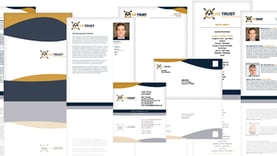If you want a great return on your money, you need to take on more risk. The general public has been conditioned to accept this as reality for decades. And there is truth to the risk reward relationship. However, it's also true that a client could potentially increase their return without exposing their hard-earned assets to additional risk. We’ll discuss three ways to do that…

#1 Help Avoid Losses
Preserving Your Client’s Future
This seems simple enough. Keep what you earn. Never lose it. Heck, Warren Buffet is famous for his two rules of investing: Rule #1, never lose money. Rule #2, never forget rule number one.
Ok, but how do you do that?
You can’t guarantee a client will avoid losses when investing, right? Right!
What a client CAN do is prevent loss due to market risk on some of their money.
But what if they say – I won’t earn anything if I’m not investing. Interest rates on bank products are paltry.
Right again. Your clients are smart investors!
However, there are places that bear interest based on an external benchmark — something you’re probably familiar with…
Indexed products.
There are indexed annuities and even indexed life insurance policies. The interest earned is based on the positive or negative movement of an external benchmark.
For example, many indexed financial products are linked to the S&P 500®. Many of them have a floor of 0%. This means that in a year the S&P 500® declines in value, a client would earn 0%. Bummer, right? Maybe not. Because on the flip side, they don’t lose anything. You helped your client preserve their money.
What about when the index is positive? In that case, clients earn index linked interest credits. As we know, there are limitations to that — They won’t earn index interest equal to the entire positive movement of the index. There could be caps and/or a participation rate or possibly a spread or margin that reduces the amount of crediting. That’s the tradeoff for avoiding the potential loss from market risk. Additionally, there could be a fee for an optional rider, such as an income rider.
The point is — this strategy can be effective for helping decrease potential loss, while still earning a competitive interest rate. The client just needs to be OK with not getting all of the upside potential of market-based investments. They can’t have all the gain without any of the risk of loss. However, loss avoidance may positively impact the overall rate of return in a volatile economy.
To be fair, clients likely won’t outpace market investments over an extended period of time, say 15 years or more. However, if they have money they can’t afford to lose in the next 10 years because they need it to sustain their retirement lifestyle, this is one way to put lower performing assets to work without subjecting them to market risk.
#2 Help Reduce Impact of Fees & Expenses
Preventing Corrosion on Client’s Retirement Money
When clients invest money, they’re going to pay for it. That’s a fact. Whether they do it themselves or hire a financial advisor, they’re going to pay someone.
A 401(k) charge fees and has administrative expenses. Commission broker-managed accounts often contain commission-based fees and administrative fees. Even fiduciary investment advisors, who by law are required to act in a client’s best interest, charge fees for managing money.
Clients should be asking themselves — How much am I paying and what am I receiving in return? and Which of my retirement assets are being charged a fee and which are not?
Obviously, as dedicated financial professionals we should be compensated — whether it’s through commissions earned or fees assessed. But the value delivered should be equal to or greater than the amount we receive in compensation.
Walk a mile in the client’s shoes…
Every 1% that clients pay in fees is 1% less they keep. If they’re paying 2% in fees and averaging 7.5% in return, then they net 5.5%. That may not sound like a big deal, however, compounded over time, the negative impact of fees can really add up!
Here’s another consideration. Which assets are getting dinged with fees, and which are not? Suppose there’s a 65-year old transitioning into retirement, and she has $350,000 in an old 401(k) at a previous employer. And let’s say the total fees on the account add up to 1%... she’ll be paying $3,500 annually on this account.
Is anyone from their previous employer advising her and her spouse on how to manage their financial life? If not, what exactly are they paying for?
Besides the fact they’re paying fees on the entire account, what if they wanted some of it to be in a place where they aren't subject to market risk. What if they want to earn some interest, like we mentioned earlier, based on positive movement of an external benchmark?
Why would they do this?
To avoid the potential for market-based loss on some of their money.
How would this near retiree be impacted working with an advisor who charges a 1.5% fee for advice on money managed in an investment account and no fee on money that’s placed in a loss mitigation strategy?
Well let’s find out: If they put $200,000 to a loss mitigation strategy and $150,000 to a managed account for long term growth, they’d pay a 1.5% fee on $150,000 and no fee on the other money. That makes their total fee $2,250 for the year for which they should expect to receive professional advice on what to do with their money. And the fee on total retirement assets went down. So, they keep more of their money.
#3 Mitigate Impact of Taxes
Tax Deferral Does Not Equal Tax Free
We’ve been conditioned to defer taxes. Certified Public Accountants, retirement plan sponsors and their third-party administrators, and others have been preaching the power of deferring taxes in retirement plans for decades. Maybe you have too. It’s understandable because even the government encourages tax deferral through their policies and public announcements. It would seem like tax deferred retirement plans are the way to go.
So why is everyone championing tax deferral?
Think about it. The government permits you to delay paying taxes on some of your retirement assets. Where do you save them? Often, they are saved in employer-sponsored, qualified plans managed by the third-party administrator. The money the client saves goes directly to Wall Street firms to buy their investments. The accountant saves a client money during tax season on last year’s taxes. The client gets a refund, and the accountant looks like a hero. This goes on and on for decades.
Then one day the client retires…
They stop working and earning a paycheck.
They stop contributing to tax deferred retirement plans.
And they begin to withdraw money from their tax deferred retirement plan to replace their paycheck.
If their investments have done well and they retire with more money than they contributed — the government wins. Their share of the client’s deferred taxes grew too. Meaning, their share of the retirement account is larger. But your client took all the risk.
The third-party administrator got paid too. What did they earn a fee for? Managing the client’s money and for providing advice on how to invest contributions? It’s doubtful they provided any guidance there.
Wall Street firms received their cut too. The third-party administrator invested the client’s money in their mutual funds, stocks, and bonds. The Wall Street firms had use of the client’s money and they received a fee for that as well.
It would seem like everyone wins until the client takes the first distribution from their tax qualified retirement plan…
How much will they owe in taxes? I don’t know. Neither do you or the client. The distribution is subject to income tax. No one knows what the tax rate will be when they need the money.
What if they thought they’d need $60,000 per year to maintain their lifestyle? Will they have enough money for the year if they withdraw $60,000 from their tax deferred retirement plan?
Perhaps not, after they pay taxes! They may need to withdraw much more.
Taxes are another cancer that can erode returns over time. Different investments are taxed differently. Dividend yield on bonds or preferred stock for example are taxed as regular income. Appreciation of securities or real estate are taxed as capital gains when sold.
Taxes will also impact how much of their Social Security check they get to keep. If they have too much income generated from tax qualified retirement plans, their Social Security check may get taxed too. In fact, up to 85% of their Social Security check could be subject to income tax, if combined income was more than $34k for single filers and $44k if filing jointly. There’s another bite out of their retirement income apple.
So, what if in working with your clients, they decide they don’t want to take distributions from a tax deferred retirement plan in order to protect Social Security benefits from being taxed? That may not be an option. After the passing of the SECURE Act, which took effect January 1, 2020, in most situations, a client will have to take their first required minimum distribution (RMD) by at least April 1st of the year they reach age 72 — whether they need the money or not. Otherwise, they face a penalty rate of 50% of the required distribution for non-compliance.
To help clients mitigate this, you might suggest putting some of their retirement savings in a Roth IRA account if they qualify, strategically convert some of the IRA money to a Roth IRA, or save some of their money into an after-tax account where most if not all taxes are paid upfront.
In Summary
These are just a few of the ways you can help a client effectively improve their returns (without the client having to take on more risk).
Prudent planning may result in less risk overall by putting the poorest performing assets to work in a strategy designed to mitigate loss while creating the potential to earn index-linked interest. They may also keep more of their money when they’re sensitive to the impact of high fees on your entire retirement portfolio. Finally, planning to mitigate the impact of future taxes in retirement may allow them to take home more retirement income.
It’s your client’s future. Keep them informed; get them involved. Presenting these ideas as “food for thought” can be a way for you to act in your client’s best interest — which is what we’re all striving to do.
If you found this blog helpful, please like or share. Better yet, subscribe to our blog by entering your name and email address below and receive more content like this.





